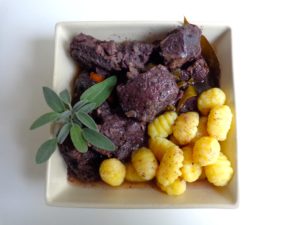
Beef stew, Provence style
It takes time — two to three days — to prepare this classic beef stew from Provence, but it’s worth the effort. The first day you marinate the beef in red wine, herbs and spices. The second day you add dried orange peel and cook the beef over low heat for 3-4 hours, producing unctuous tenderness and an unbeatable flavor. If you choose, you can wait to serve the beef until the third day, allowing the flavor to deepen.
There are probably as many recipes for daube as there are cooks in France. Many include bacon, tomatoes, carrots, black olives and/or anchovy filets (see below). My version omits these ingredients and instead uses fresh sage, which I find marries well with the beef.
For best results, choose a combination of two or three cuts of stewing beef, for example chuck, round or tip steak (American cuts), or gîte, noix or paleron (French cuts). For the cooking wine, choose a drinkable hearty red.
Serve the daube with fresh tagliatelle, gnocchi or boiled potatoes, preceded or followed by a green salad. And of course some crusty bread and a good bottle of red, for example Côtes du Rhone or another wine from Provence.
The ingredients below are grouped into separate lists for the two days of cooking. The quantities will serve 3-4 people — you can double the recipe for a larger crowd.
Ingredients for Day One:
1 pound (500 g) stewing beef (see above)
1 bottle hearty red wine
1 tbsp. red wine vinegar
2 onions
2 cloves garlic
2 bay leaves
several branches fresh thyme or 1 tsp. dried thyme
4 cloves
10 whole peppercorns
1 organic orange
Ingredients for Day Two:
2 onions
2 cloves garlic
3 tbsp. olive oil
2 bay leaves
2 branches fresh thyme or 1/2 tsp. dried thyme
2 branches fresh sage, plus more for decoration
the dried peel of the orange
1 tsp. salt or more to taste
freshly ground black pepper
2 cups (1/2 liter) water
Cooking the daube: Day One
Cut the beef into large cubes about 2 inches (5 cm) per side. Place the meat in a large glass or ceramic bowl. Cover with the wine. Add the vinegar.
Peel the onions, chop into quarters and add. Peel the garlic, chop into halves and add. Add the bay leaves, thyme, cloves and peppercorns. Cover and refrigerate.
Peel the orange with a sharp paring knife. Set the peel in a warm place to allow it to dry out. You will need a couple slices of peel about 2 inches (5 cm) long.
Cooking the daube: Day Two
Remove your bowl from the fridge and pour its contents through a colander placed over a large recipient. Lift out the beef cubes and pat them dry with paper towels. Discard the colander’s other ingredients, reserving the marinade.
Peel and finely mince the onions and garlic.
In a heavy-bottomed stew pot, heat the olive oil to sizzling. Add the beef cubes. Brown well on all sides — this takes about five minutes.
Add the onions and garlic and sauté one minute more.
Pour in the marinade. Add the bay leaves, thyme, sage and dried orange peel. Add the salt and grind in some black pepper. Add the water.
Bring to a simmer, then turn the heat down to very low. Cover the pot and simmer for 3-4 hours, stirring occasionally. The daube is done when the meat is tender enough to be easily cut with the edge of a spoon.
Taste and adjust the seasonings as necessary.
Reheat gently just before serving — or allow the daube to cool, refrigerate overnight and reheat the next day. It will be even better.
Decorate with some fresh sage leaves. Serves 3-4.
Variations (all for Day Two):
1) Chop up a thick slice of bacon and add to the pot while you’re sautéing the onions, i.e. before adding the marinade.
2) Add 1 tbsp. tomato paste or 2 peeled and chopped tomatoes to the pot after sautéing the onions. Cook briefly before adding the marinade.
3) Peel a couple of carrots, slice into thin rounds and add to the stew pot one hour before the daube has finished cooking.
4) Add a handful of pitted black olives to the pot one hour before the daube has finished cooking.
5) Blend three anchovy filets with a peeled clove of garlic and add to the pot 15 minutes before serving.




